Scaling up note: Ghana
Scaling up note: Ghana
December 2015
Since the mid-1980s, Ghana’s impressive development has made the country one of the strongest performers in Africa, although economic challenges and a fiscal deficit are currently slowing down the pace of growth. About 40 per cent of the rural population (or five million people) in Ghana live below the national poverty line. With approximately 90 per cent of farm holdings of less than 2 hectares, Ghanaian agriculture is still dominated by traditional smallholder farms. Rural poor and foodinsecure households consist mainly of smallholder food crop farmers with limited access to markets. This results in low productivity of land and labour, poverty, low investment capacity and a lack of opportunities for young people. Nevertheless, domestic and regional demand for food crops is strong and although agribusinesses are interested in working with smallholders, they are asking for more formalized business relationships along the value chains. Rural women and girls contribute significantly to farm labour, particularly as a result of the high migration rates among young men stemming from the lack of economic opportunities. This has produced an ageing and generally less dynamic rural population, high rates of youth unemployment, underemployment and social inequality.
